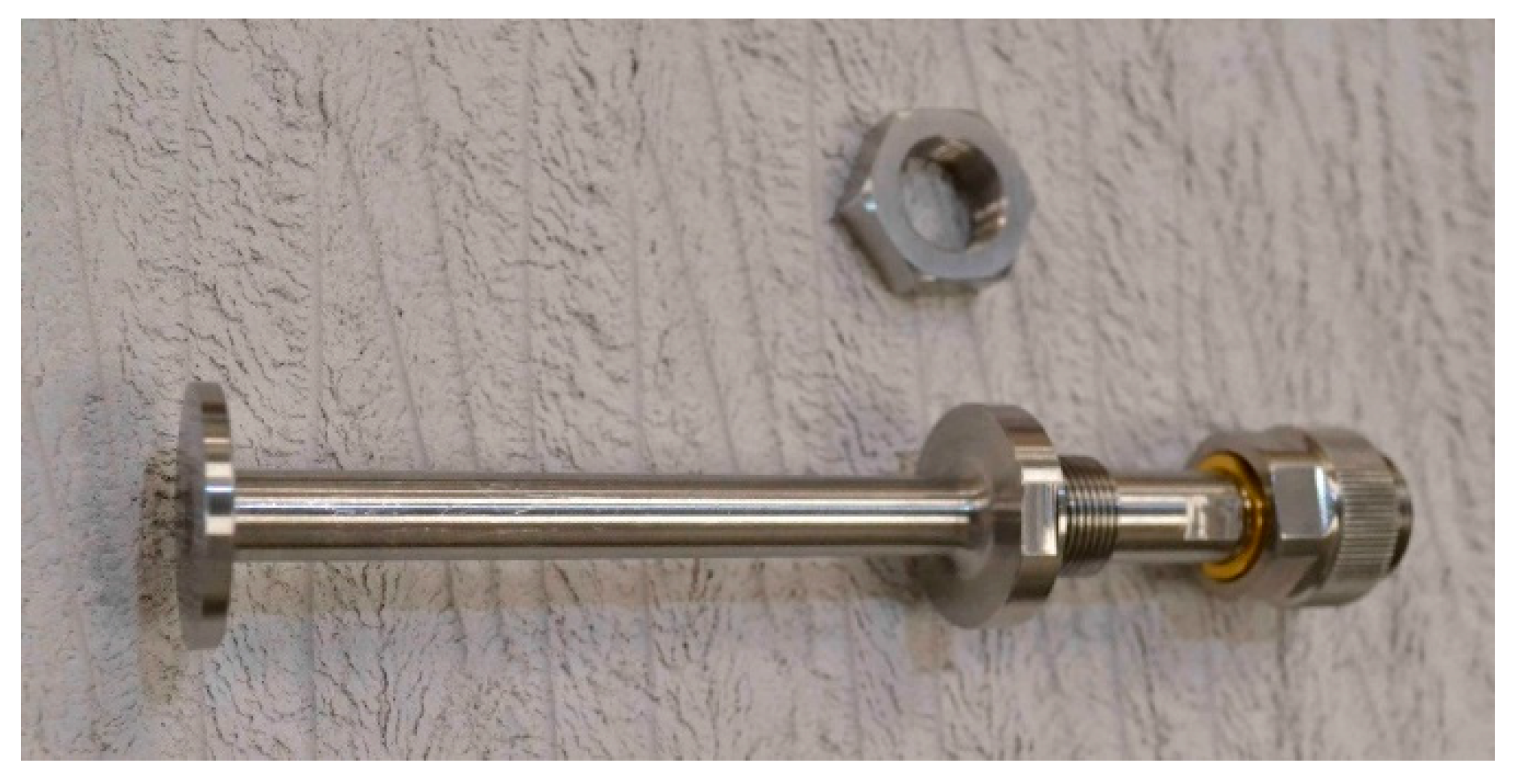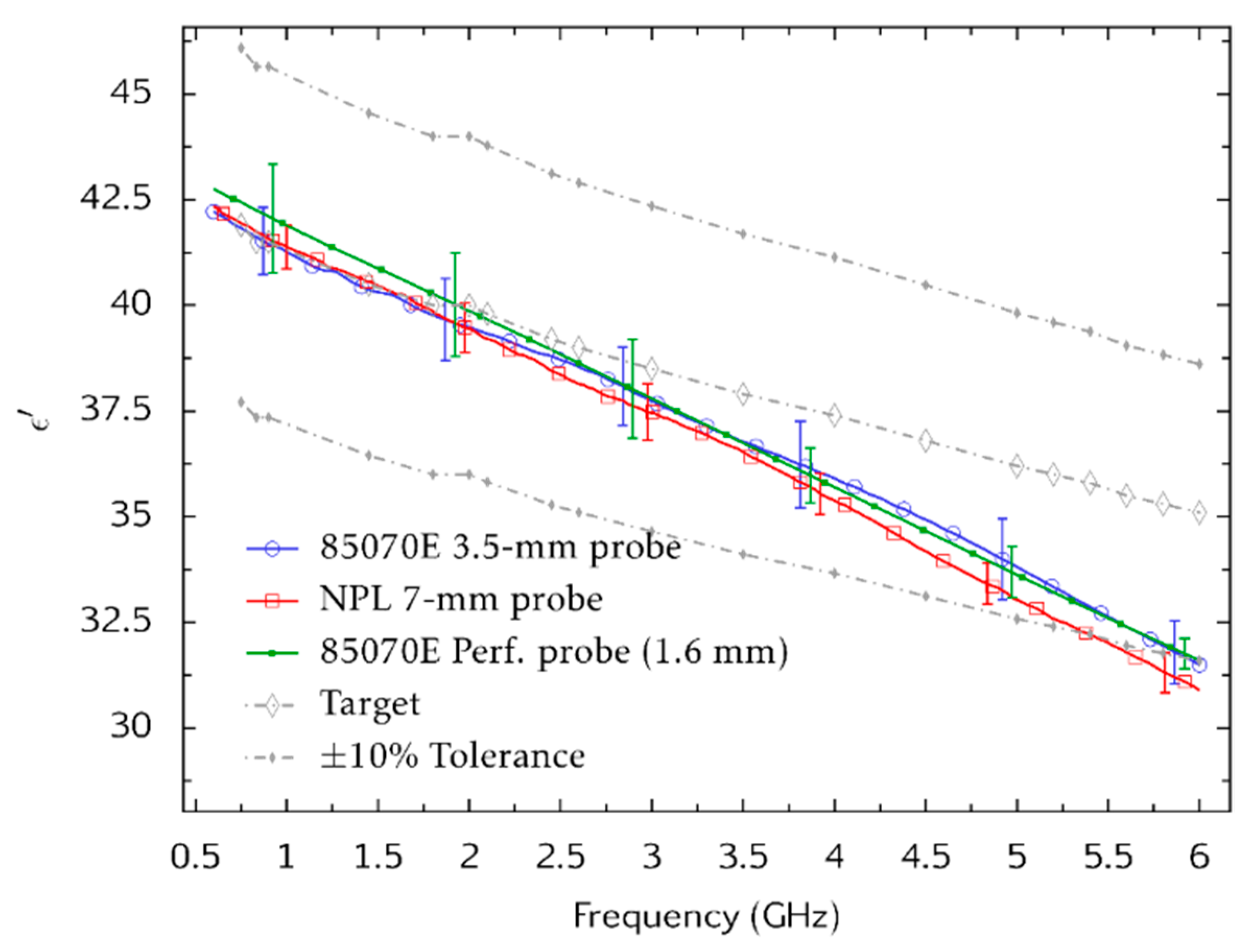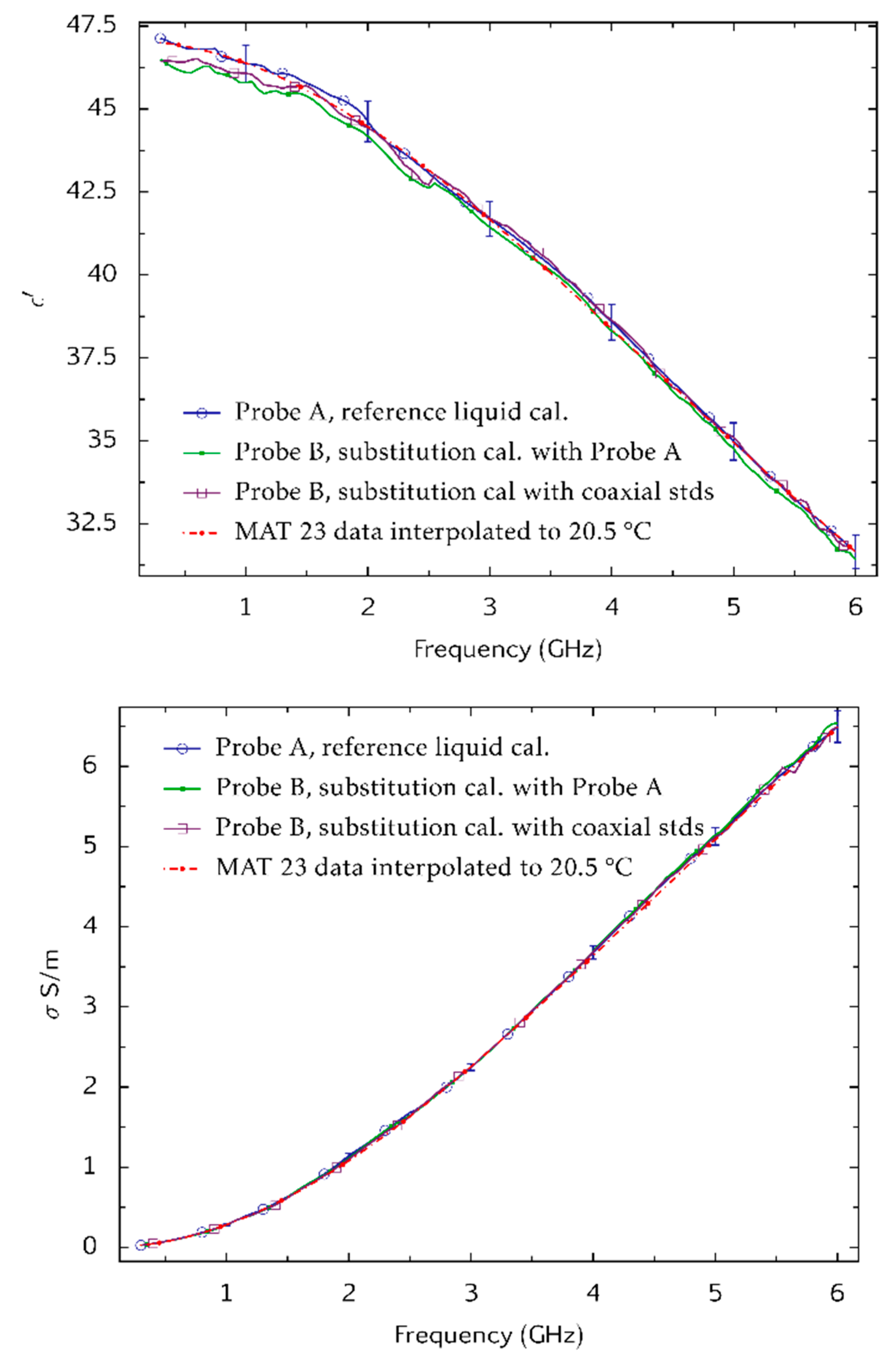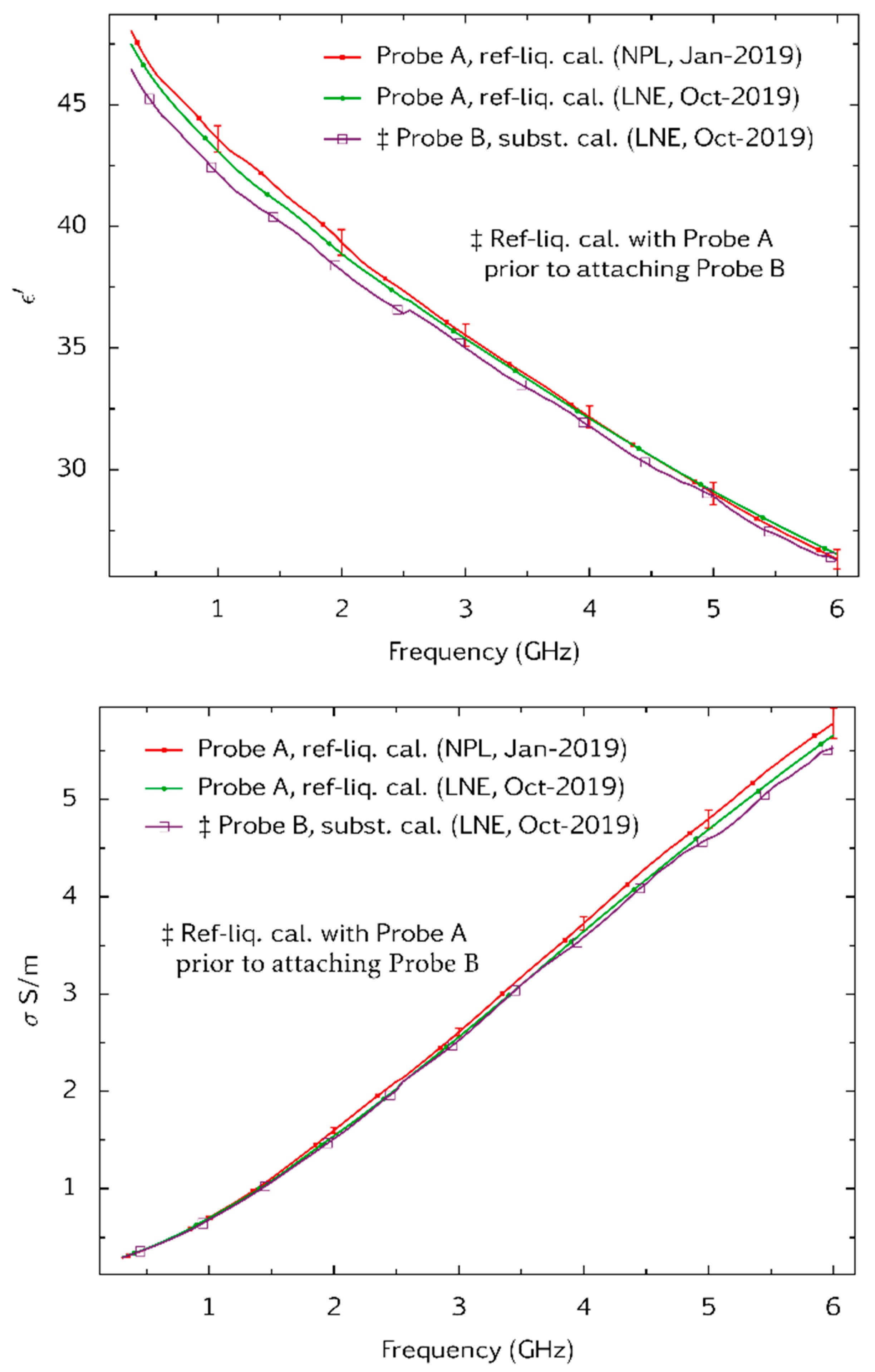Validation of a Broadband Tissue-Equivalent Liquid for SAR Measurement and Monitoring of Its Dielectric Properties for Use in a Sealed Phantom
Abstract
:1. Introduction
2. Materials and Methods
2.1. Equations for the Substitution Calibration
- (1)
- Probe A is calibrated by using short-circuit, open-circuit and reference liquid standards by the conventional manner. This determines the complex calibration coefficients , and of the bilinear equation:in which is the uncorrected complex reflection coefficient (S11) measured by the VNA, and is the corrected complex reflection coefficient for a reference plane at the face of probe A.
- (2)
- Probe B is attached to the same VNA port and is also calibrated by using short-circuit, open-circuit and reference liquid standards. However, there is an important difference: the data read from the VNA is already corrected by the Probe A calibration. The corrected complex reflection coefficient for a reference plane at the face of Probe B is given by the bilinear equation:where , and are complex calibration coefficients. These coefficients are retained for use after Probe B has been embedded in the tank. Note that if the probes match perfectly, then and .
2.2. A Variation on the Substitution Method That Uses GPC-7 Coaxial Standards
3. Results
3.1. Characterisation of a New Broadband Phantom Liquid
3.1.1. Measurement of Stability over a Period of Time
3.1.2. Inter-Laboratory Measurement Comparison
3.2. Evaluation of the Substitution Method of Calibration
4. Discussion
Author Contributions
Funding
Acknowledgments
Conflicts of Interest
References
- Kouzai, M.; Nishikata, A.; Fukunaga, K.; Miyaoka, S. Complex Permittivity Measurement at Millimetre-Wave Frequencies During Fermentation Process of Japanese Sake. J. Phys. D Appl. Phys. 2007, 40, 54. [Google Scholar] [CrossRef]
- Guo, C.; Xin, L.; Dong, Y.; Zhang, X.; Wang, X.; Fu, H.; Wang, Y. Dielectric Properties of Yogurt for Online Monitoring of Fermentation Process. Food Bioprocess Technol. 2018, 11, 1096–1100. [Google Scholar] [CrossRef]
- Blakey, R.T.; Morales-Partera, A.M. Microwave dielectric spectroscopy—A versatile methodology for online, non-destructive food analysis, monitoring and process control. Eng. Agric. Environ. Food 2016, 9, 264–273. [Google Scholar] [CrossRef]
- Kalamiotis, A.; Ilchev, A.; Irvine, D.J.; Dimitrakis, G. Optimised use of dielectric spectroscopy at microwave frequencies for direct online monitoring of polymerisation reactions. Sens. Actuators B Chem. 2019, 290, 34–40. [Google Scholar] [CrossRef]
- Yuan, C.; Bowler, A.; Davies, J.G.; Hewakandamby, B.; Dimitrakis, G. Optimised mode selection in electromagnetic sensors for real time, continuous and in-situ monitoring of water cut in multi-phase flow systems. Sens. Actuators B Chem. 2019, 298, 126886. [Google Scholar] [CrossRef]
- Kraszewzki, A. Microwave Aquametry: Electromagnetic Wave Interaction with Water-Containing Materials; IEEE: Piscataway, NJ, USA, 1996; ISBN 0780311469. [Google Scholar]
- Kapilevich, B.; Litvak, B. Microwave measurements of dielectric properties using a gap-coupled multi-mode coaxial resonator. Measurement 2014, 48, 21–48. [Google Scholar] [CrossRef]
- Sharma, P.; Yeung, H. Recent advances in water cut sensing technology, Chapter 4. In Advances in Measurements and Instrumentation; IFSA Publishing: Barcelona, Spain, 2019; Volume 1, ISBN 978-84-09-07321-4. [Google Scholar]
- Human Exposure to Radio Frequency Fields from Handheld and Body-mounted Wireless Communication Devices—Human Models, Instrumentation, and Procedures—Part 3: Vector Measurement-based Systems (Frequency Range of 600 MHz to 6 GHz). IEC Standard 62209-3:2019. Available online: https://webstore.iec.ch/publication/30773 (accessed on 21 May 2020).
- Aberbour, L.; Jawad, O.; Ramdani, M.; Giry, P.; Julien, T. Efficient experimental assessment of the specific absorption rate (SAR) induced by MIMO wireless communication devices: Application of vector near-field measurement system. In Proceedings of the 2018 IEEE Conference on Antenna Measurements & Applications (CAMA), Vasteras, Sweden, 3–6 September 2018. [Google Scholar] [CrossRef] [Green Version]
- Recommended Practice for Determining the Peak Spatial-average Specific Absorption Rate (SAR) in the Human Head from Wireless Communications Devices: Measurement Techniques. IEEE Standard 1528-2013. Available online: https://ieeexplore.ieee.org/document/6589093 (accessed on 21 May 2020). [CrossRef]
- IEEE Standard for Safety Levels with Respect to Human Exposure to Radio Frequency Electromagnetic Fields, 3 kHz to 300 GHz. IEEE Standard C95.1-2005. Available online: https://ieeexplore.ieee.org/document/1626482 (accessed on 21 May 2020). [CrossRef]
- Measurement Procedure for the Assessment of Specific Absorption Rate of Human Exposure to Radio Frequency Fields from Hand-held and Body-mounted Wireless Communication Devices—Part 1: Devices Used Next to the Ear (Frequency Range of 300 MHz to 6 GHz). IEC Standard 62209-1:2016. Available online: https://webstore.iec.ch/publication/25336 (accessed on 21 May 2020).
- Human Exposure to Radio Frequency Fields from Hand-held and Body-mounted Wireless Communication Devices—Human Models, Instrumentation, and Procedures—Part 2: Procedure to Determine the Specific Absorption Rate (SAR) for Wireless Communication Devices Used in Close Proximity to the Human Body (Frequency Range of 30 MHz to 6 GHz). IEC Standard 62209-2:2010. Available online: https://webstore.iec.ch/publication/6590 (accessed on 21 May 2020).
- Clarke, R.N. Guide to the Characterisation of Dielectric Materials at RF and Microwave Frequencies; The Institute of Measurement and Control (IMC) and The National Physical Laboratory: London, UK, 2003; ISBN 0904457389. [Google Scholar]
- Loader, B.G.; Gregory, A.P.; Mouthaan, R. Formulation and Properties of Liquid Phantoms, 1 MHz to 10 GHz; Report TQE 9; National Physical Laboratory: London, UK, 2018. [Google Scholar]
- Quelever, K.; Coradin, T.; Bonhomme, C.; Meyer, O.; Derat, B. Composition Simulating the Dielectric Properties of the Human Body and Use Thereof for SAR Measurement. U.S. Patent PCT WO2013079621 (A1), 6 June 2013. [Google Scholar]
- Mouthaan, R.; Loader, B. A Wideband Tissue-Equivalent Liquid for Multiband Specific Absorption Rate Measurements (850 MHz to 2.5 GHz). Electron. Lett. 2016, 52, 176–177. [Google Scholar] [CrossRef]
- Grant, J.P.; Clarke, R.N.; Symm, G.T.; Spyrou, N.M. A critical study of the open-ended coaxial line sensor for RF and microwave complex permittivity measurements. J. Phys. E Sci. Instrum. 1989, 22, 757–770. [Google Scholar] [CrossRef]
- Gregory, A.P.; Clarke, R.N. Dielectric metrology with coaxial sensors. Meas. Sci. Tech. 2007, 18, 1372–1386. [Google Scholar] [CrossRef]
- Gregory, A.P.; Clarke, R.N. Tables of the Complex Permittivity of Dielectric Reference Liquids at Frequencies up to 5 GHz; Report MAT 23; National Physical Laboratory: London, UK, 2012. [Google Scholar]
- Gregory, A.P.; Clarke, R.N. A Review of RF and Microwave Techniques for Dielectric Measurements on Polar Liquids. IEEE Trans. Dielectr. Electron. Insul. 2006, 13, 727–743. [Google Scholar] [CrossRef]
- Gregory, A.P.; Clarke, R.N.; Hodgetts, T.E.; Symm, G.T. RF and Dielectric Measurements on Layered Materials Using Coaxial Sensors; Report MAT 13; National Physical Laboratory: London, UK, 2008. [Google Scholar]
- Reyes-Vera, E.; Acevedo-Osorio, G.; Arias-Correa, M.; Senior, D.E. A Submersible Printed Sensor Based on a Monopole-Coupled Split Ring Resonator for Permittivity Characterization. Sensors 2019, 26, 1936. [Google Scholar] [CrossRef] [PubMed] [Green Version]
- Vlachogiannakis, G.; Spirito, M.; Pertijs, M.A.P.; de Vreede, L.C.N. A 40-nm CMOS Complex Permittivity Sensing Pixel for Material Characterization at Microwave Frequencies. IEEE MTT 2018, 66, 1619–1634. [Google Scholar] [CrossRef] [Green Version]
- Oliveira, J.G.D.; Pinto, E.N.M.G.; Silva Neto, V.P.; D’Assunção, A.G. CSRR-Based Microwave Sensor for Dielectric Materials Characterization Applied to Soil Water Content Determination. Sensors 2020, 20, 255. [Google Scholar] [CrossRef] [PubMed] [Green Version]
- Warham, A.G.P. Annular Slot Antenna Radiating into Lossy Material; Report DITC 152/89; National Physical Laboratory: London, UK, 1989. [Google Scholar]
- Keysight Technologies. Keysight 85070E Dielectric Probe Kit 200 MHz to 50 GHz—Technical Overview. Available online: https://www.keysight.com/us/en/assets/7018-01196/technical-overviews/5989-0222.pdf (accessed on 21 May 2020).











| Frequency Ranges | Relative Permittivity Uncertainty (ε′) | Conductivity (σ) Uncertainty (S/m) |
|---|---|---|
| 600 MHz to 1 GHz | 1.92% | 3.72% |
| 1 GHz to 3 GHz | 2.43% | 4.69% |
| 3 GHz to 5 GHz | 2.81% | 7.42% |
| 5 GHz to 6 GHz | 2.35% | 7.92% |
© 2020 by the authors. Licensee MDPI, Basel, Switzerland. This article is an open access article distributed under the terms and conditions of the Creative Commons Attribution (CC BY) license (http://creativecommons.org/licenses/by/4.0/).
Share and Cite
Gregory, A.P.; Quéléver, K.; Allal, D.; Jawad, O. Validation of a Broadband Tissue-Equivalent Liquid for SAR Measurement and Monitoring of Its Dielectric Properties for Use in a Sealed Phantom. Sensors 2020, 20, 2956. https://doi.org/10.3390/s20102956
Gregory AP, Quéléver K, Allal D, Jawad O. Validation of a Broadband Tissue-Equivalent Liquid for SAR Measurement and Monitoring of Its Dielectric Properties for Use in a Sealed Phantom. Sensors. 2020; 20(10):2956. https://doi.org/10.3390/s20102956
Chicago/Turabian StyleGregory, Andrew P., Kristell Quéléver, Djamel Allal, and Ourouk Jawad. 2020. "Validation of a Broadband Tissue-Equivalent Liquid for SAR Measurement and Monitoring of Its Dielectric Properties for Use in a Sealed Phantom" Sensors 20, no. 10: 2956. https://doi.org/10.3390/s20102956
APA StyleGregory, A. P., Quéléver, K., Allal, D., & Jawad, O. (2020). Validation of a Broadband Tissue-Equivalent Liquid for SAR Measurement and Monitoring of Its Dielectric Properties for Use in a Sealed Phantom. Sensors, 20(10), 2956. https://doi.org/10.3390/s20102956





